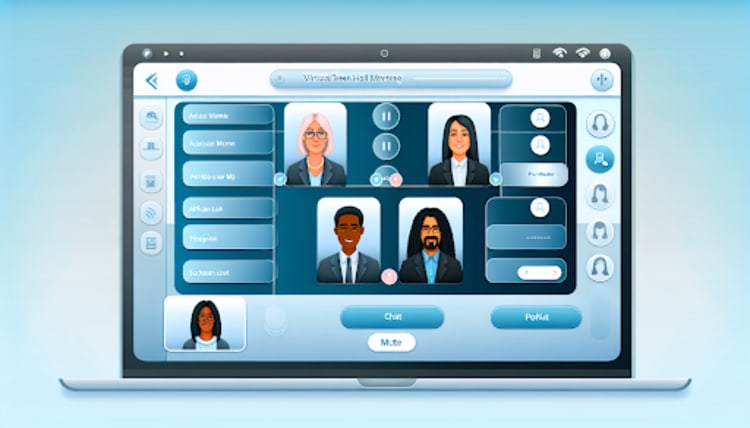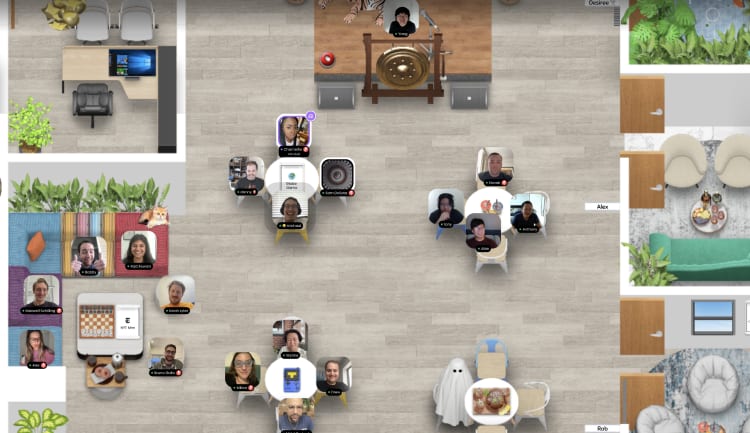Need to bridge the distance in your team with a virtual town hall meeting? This guide is your blueprint for connecting management and employees effectively through digital means. Here, you’ll learn to select apt technology, drive engagement, and align your team’s mission—all in a few key steps. Prepare to build a more unified, motivated workforce with our straightforward tips.
Key takeaways
- Virtual town hall meetings are integral for aligning employees with company goals, facilitating interactive discussions, and building corporate culture through various engaging and inclusive activities.
- Crafting a well-structured town hall agenda with key elements like introductions, company updates, Q&A sessions, and guest speakers is essential, as is choosing the right timing and pacing for maximum participation across time zones.
- Selecting the right technological platform is crucial for the success of a virtual town hall meeting, with features like breakout rooms, polls, real-time chat, and a reliable tech team ready to support the event.
Virtual town hall meetings unveiled

A virtual town hall meeting, also known as an online town hall meeting, is an online company-wide event that serves multiple purposes. It keeps the workforce updated about business results, changes, and the general direction of the company, aligning everyone to the same goals. This alignment is key to closing the gap between management and employees and building a strong corporate culture.
The benefits of virtual town hall meetings include:
- Increased employee engagement
- Alignment with shared values and objectives
- Facilitate question-and-answer-based interaction
- Distinguish from all-hands meetings that focus on presenting a message and key presentations.
Platforms like Zoom have eased the transition to virtual town hall meetings by enabling companies to involve all employees without the need for travel, promoting inclusivity regardless of geographic location. However, platforms like Kumospace have taken this a step further, offering a more engaging and interactive town hall meeting experience.
Crafting the ideal virtual town hall agenda

Crafting a well-structured agenda, one that aligns with the company’s mission and objectives is a crucial step toward a successful virtual town hall meeting. This includes setting clear and specific objectives such as introducing new product features or sharing strategic changes.
A well-structured agenda keeps the content focused and encourages active employee engagement.
Key elements of a town hall meeting agenda
A typical company town hall meeting agenda includes an introduction, company updates, and a closing Q&A session. For larger companies, the focus of company town hall meetings is more on deep engagement with celebrations, announcements, and employee questions. This ensures the meeting is valuable and facilitates complex internal communication.
Encouraging employees to participate by submitting their questions or topics in advance has several benefits:
- It streamlines the Q&A portion of the meeting and allows speakers to prepare thoughtful responses.
- It encourages active participation from employees.
- It helps maintain engagement throughout the meeting.
To bring freshness to the discussion and promote open dialogue among participants, consider inviting guest speakers to the town hall. They can present new topics and provide new insights, adding another layer of engagement to your virtual town hall meeting.
Timing and pacing for maximum engagement
As you plan a virtual town hall meeting, consider timing and pacing as crucial factors. To include employees across different time zones, mid-week or end-of-week slots are typically the best. Specifically, Thursday at 6:00 PM IST has been popular for diverse audiences.
For longer meetings, scheduled breaks are recommended. These help attendees relax and re-engage with the content, ensuring they maintain their attention throughout the event.
The size of the audience is another key factor in structuring the timing of sessions and participatory activities like Q&A. For larger audiences, engagement-driven elements such as games and trivia can be organized to keep the audience attentive and engaged. The chosen platform should support the number of participants, manage varying time zones, and align with the event’s engagement goals.
Inclusion of interactive activities
For any successful virtual town hall meeting, incorporating interactive elements is critical. They give employees a voice and foster open dialogue. Activities such as live polls and Q&A sessions, with questions being collected in advance, ensure impromptu participation during the event.
Virtual breakout rooms and collaborative games like virtual charades and virtual escape rooms offer a way for teams to work together and engage deeply with the town hall content. Humorous and creative breaks, like virtual Pictionary, Bingo, trivia, jam sessions, and cooking classes, foster team spirit and introduce friendly competition, making the town hall an event to remember.
To ensure active engagement, advanced planning is necessary. Here are some tips to create a successful virtual town hall:
- Mix up presentation styles like panel discussions to maintain interest throughout the event.
- Create a relaxed and welcoming atmosphere to support open conversations.
- Make the content memorable and engaging for all attendees.
By following these tips, you can ensure that your virtual town hall is a success.
The technology behind effective virtual town halls

Next, we’ll explore the technology that powers these virtual town hall meetings. Platforms like Kumospace offer an exceptional experience for hosting such events. They integrate key features such as:
By integrating all necessary components into one suite, streamlining the company town hall setup becomes much more efficient, paving the way for the next town hall and future town halls.
Choosing the right platform
A few key features should be considered when selecting a virtual meeting platform. These include:
- Breakout rooms
- Speed networking
- Polls
- Q&A
- Superior moderation
- Real-time chat functions
These features are crucial for a successful virtual town hall meeting.
A platform that offers live streaming, interactive features, and technical support capabilities is essential for participant inclusion. The chosen platform must be user-friendly and accessible to ensure full engagement and avoid excluding any participants.
Factors like the audience’s size and technical proficiency, along with the desired level of engagement, are key considerations when selecting a virtual meeting platform. Platforms like Kumospace provide an engaging and interactive experience for virtual town hall meetings, making them a top choice for many companies.
Preparing your tech team
For the smooth execution of a virtual town hall meeting, it’s vital to have an in-house tech team ready for potential technical errors. This team made up of volunteers for moderation and technical support, can include roles such as a moderator, IT staff, and possibly a professional emcee.
To minimize the risk of technical errors during the town hall, it is essential to perform a technical dry run the day before the meeting. This involves:
- Setting up and testing the meeting software
- Testing the chat app
- Testing the event tools
- Testing connectivity
Having a contingency plan for handling potential technical errors is vital to minimize disruption and ensure continuous operation during the town hall meeting. Clear roles should be assigned to manage interactive elements and keep the virtual meeting on track, ensuring every team member knows their responsibilities.
Engaging your audience: from leadership to every employee

After crafting the agenda and choosing the platform, the subsequent step is engaging the audience. From leadership to every employee, everyone’s involvement is crucial in making virtual town hall meetings a success. Let’s dive into the strategies that can help achieve this.
Role of senior leaders in driving engagement
During town hall meetings, company executives play a pivotal role in driving engagement. By leading by example, they create better communication channels and more interaction between the C-Suite and employees. This often starts with an executive or CEO setting an inspiring tone at the start of the town hall.
The senior leadership team, consisting of senior leaders, is instrumental in fostering a culture of openness and strengthening employee trust. They can do this by being prepared to discuss key updates, future plans, and addressing questions transparently.
By setting a motivational agenda that includes leadership speeches, recognition sessions, and aligning with company values, senior leaders play a pivotal role in boosting team morale. Platforms like Kumospace enable leaders to dynamically and inclusively connect with their teams, enhancing engagement during virtual town hall meetings.
Recognizing employee contributions
To promote a sense of belonging and develop a high-performance company culture, it’s effective to recognize employee contributions. Celebrating employee achievements during the town hall can make employees feel valued and appreciated.
Segments to include in the virtual town hall meeting agenda:
- Welcome new team members
- Recognize work anniversaries
- Celebrate birthdays
- Acknowledge notable departures
Birthday celebrations can be included in town hall agendas through monthly acknowledgments, delivering cakes, or playing virtual games, making the event more engaging and inclusive.
Rewarding top performers with virtual tokens of appreciation, such as Hoppier cards, creates an incentive for high achievement and boosts employee morale.
Facilitating open dialogue
Employees are given a platform to engage in open dialogue through virtual town hall meetings. They can ask questions, share their thoughts, and provide feedback to senior management. Involving the audience through polls, questions, and feedback during the session can make the virtual town hall meeting more engaging.
Ending the town hall with a live Q&A session, including curated and spontaneous questions, can enhance two-way communication and engagement. Creating a dedicated talk space or channel for real-time discussion allows attendees to contribute to the virtual town hall meeting. Such spaces ensure that all voices are heard and concerns are addressed in real time.
These discussions can lead to better strategies for stimulating open dialogue among employees.
Post-town hall follow-up: ensuring lasting impact

The impact of a virtual town hall meeting is assessed not only by what occurs during the event but also by the aftermath. A thorough and thoughtful follow-up is crucial to ensure the event’s benefits are sustained long-term.
Sharing meeting outcomes
To ensure information reaches, recording the town hall meeting and making the recording accessible to employees post-event is beneficial. This includes those who could not attend and helps keep key discussions and decisions in organizational memory.
The recap email sent to participants should include:
- The agenda
- Notes
- Key takeaways
- Action items
- Discussion points
This ensures clarity in communication and accountability for follow-up actions.
Creating a dedicated channel for real-time discussion about the town hall meeting can continue the engagement, provide a space for questions to be raised, and allow for further reflection on the meeting’s content.
Gathering feedback for future meetings
To improve future virtual town hall meetings, it’s essential to collect feedback. Surveys or suggestion boxes leading up to the meeting are effective for incorporating employee feedback into town hall meetings.
Simple feedback polls with questions on meeting likes, dislikes, and areas for improvement can yield actionable insights from employees. Quantifying employee feedback on the town hall event through star ratings in the employee newsletter can also be beneficial.
Regular collection and analysis of feedback regarding town hall meetings can lead to better strategies for stimulating open dialogue among employees. This helps pinpoint trends and improvements, which is vital for enhancing the quality of future virtual town hall meetings.
Transforming the virtual experience with Kumospace

The virtual town hall experience is transformed by a platform called Kumospace. It features:
- Custom images and GIFs for branding
- Virtual drink stations
- YouTube streaming on virtual TVs
- Secondary camera presentation, which enhances the virtual town hall experience.
Kumospace supports group broadcasts suitable for group presentations or panel discussions, adding to the collaborative aspect of town hall meetings. It provides pre-designed floor templates and allows for real-time adjustment of floor settings and participant management, encouraging dynamic interaction during the town hall.
Hosts can invite guests through the in-platform invite button, direct links, or sharing the unique Kumospace URL, offering flexible options for attendees to join the event. This makes Kumospace an ideal choice for hosting memorable virtual town hall meetings.
Summary
To wrap up, virtual town hall meetings are a powerful tool for fostering open communication, alignment, and engagement within a company. Crafting a well-structured agenda, choosing the right technology, and facilitating open dialogue are key to hosting successful virtual town hall meetings. Platforms like Kumospace offer an ideal solution, providing interactive and engaging experiences for all attendees.
Frequently asked questions
To conduct a virtual town hall meeting, first define the meeting objective, plan the agenda, prepare content, send invitations, invite questions in advance, perform a technical dry run, and welcome your attendees. This will help ensure a successful and engaging virtual town hall meeting.
Virtual town halls are digital versions of traditional town hall meetings, allowing for updates, feedback collection, and two-way communication with the workforce.
To host a virtual town hall meeting with Kumospace, start by selecting a date and inviting all relevant participants. Ensure that your Kumospace account is set up and ready for the event, including any necessary configurations or customizations. Schedule the meeting within Kumospace and provide technical assistance to attendees as needed. Determine whether the meeting format will be a live session within Kumospace's virtual environment or a webinar-style presentation. By following these steps and leveraging the features of Kumospace, you can effectively host a successful and engaging virtual town hall meeting.
Virtual town halls offer the benefits of live updates, performance reviews, goal tracking, and community building among colleagues. They provide a platform for company leaders to connect with employees and foster a sense of community.
The purpose of a virtual town hall meeting is to keep the workforce informed about business results, changes, and the company's general direction, align everyone to the same goals, and build a strong corporate culture. It helps to ensure everyone is on the same page and working towards common objectives.





